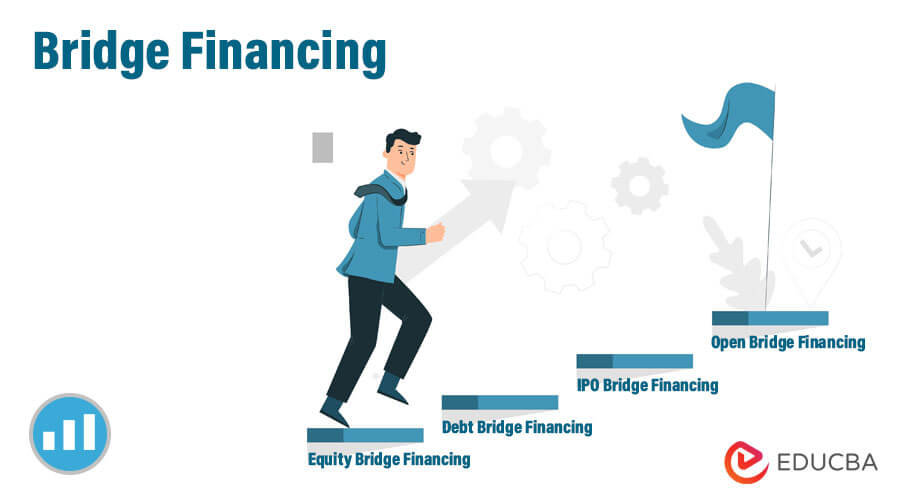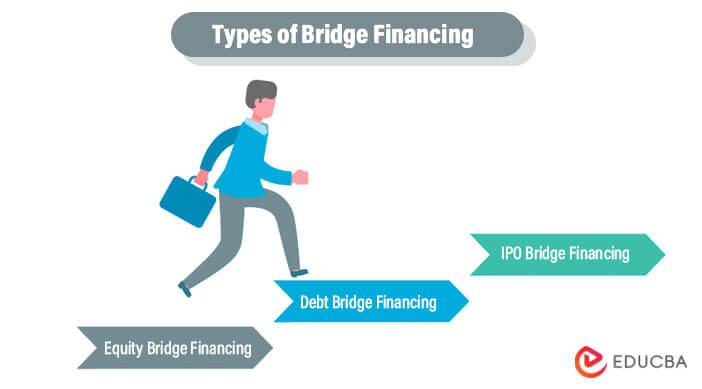Updated July 13, 2023

Definition of Bridge Financing
Bridge financing is a type of loan taken from commercial banks for a short span of time. Whenever a company asks for a loan from any financial institution, the entire process takes time.
Financial institutions take time to disburse the loan to companies, and therefore, in that case, this concept comes. If the loan from the financial institution is approved, then the company can take a short-term loan from the commercial banks and can start their projects, and when the loan disbursement from the financial institution is done, then the time the loan is taken from the commercial banks is cleared first.
How Does it Work?
Bridge financing is basically a method that helps companies to generate finance by taking short-term loans from commercial banks. Commercial banks give the loan at a somewhat high rate of interest compared to the rate of interest in any term loan. When the approved term loan is disbursed to the company at that time, the commercial bank loan is cleared. The concept of this is to make the working of the company smooth so that the basic operations should not get hindered due to lack of funds.
Example
A company has sanctioned a loan from a financial institution @18% p.a. The company has already started its business operations, and the company’s finances rose. Therefore, the management decided to ask the financial institution regarding the availability of the loan amount on time. Still, the financial institution denied offering the loan on time. Thus the management decided to take the loan from another financial institution where the rate of interest was not that high, but a small amount of the loan was taken from the second party. This type of loan is called bridge financing. This means financing the company for a short period of time until the loan from the financial institution is recovered.
Types of Bridge Financing
There are three types:
1. Equity Bridge Financing
In this type, the company takes a loan from the venture capital firm in exchange for equity ownership. Venture capital offers such deals to companies if the company’s profitability or sustainability is good. In some cases, the venture capital firm is being offered equity ownership in exchange for a financial loan. This situation arises when the company is unwilling to take on debts.
2. Debt Bridge Financing
In this type of bridge financing, the company takes the debt from the commercial banks knowing the high-interest rate, and after getting the big amount loan sanctioned earlier, the commercial bank loan is repaid. In this type of situation, the company is ready to take the risk, and thus the debt bridge financing comes into the picture.
3. IPO Bridge Financing
In this case, a company takes a loan for the purpose of getting an IPO. When a company announces IPO at that time, the company incurs a huge expense to finance that expenses sometimes company demands finances, and thus, it is known as IPO bridge financing. The rate of interest, in this case, is also on the higher side, but the company takes the loan to cover this expense.
When Should we use Bridge Financing?
Bridge financing is helpful for the company if a big amount of loan is not received on time. The company’s work depends on its finances, and thus the companies are required to take some small-ticket loans from commercial banks or venture capital firms. The company also bears a high-interest rate for the same. After the big sanctioned amount of loan is realized, the company pays off the short-term loan. This is the system of bridge financing and thus is the reason why bridge financing is being used.
Cost of Bridge Financing
It is costlier than normal loans. On average, the interest on the bridge loan is approximately 12% to 18% p.a. The company has to bear the processing fees as well. The processing fees for the bridge loan are comparatively high. Thus if the loan is not sanctioned on time, the company has to bear this cost to make its business official.
Advantages
- The time taken to sanction this type is loan is very little.
- It also helps to improve the credit rating of the company. In addition, the quick loan sanctioning and the easy repayment methods make it more popular.
- Quick business needs are fulfilled with this type of financing.
- A smart way to expense out the needs of the company’s finances.
- It helps to acquire the short-term loan when the long-term or big amount loan fails to get approved on time.
Disadvantages
- The rate of interest in this type of loan is higher than the normal loans taken for financing purposes.
- The company is also required to submit some collateral before the sanctioning of the loan.
- The interest rate and processing fees are very high in comparison to other types of loans.
- In this, the risk is also very high, and thus this type of loan should be cleared first when the long-term loan is received.
- This can increase the cost of the company because of its premium interest rate.
Key Takeaway
- It is a short-term loan that is taken to fulfill the immediate requirement of the business operations.
- Normally the working capital requirement is covered in this type of financing.
- It is a loan taken to supplement the timing of getting the long-term loan sanctioned.
Conclusion
Bridge financing is a very smart and efficient way to arrange finances on time. The immediate requirement of the loan is settled with this type of loan. Bridge financing is a very lucrative method because it helps the business continue its operation in a financial crisis.
Recommended Articles
This is a guide to Bridge Financing. Here we discuss the definitions, types, and working of Bridge Financing along with its advantages and disadvantages. You may also have a look at the following articles to learn more –



